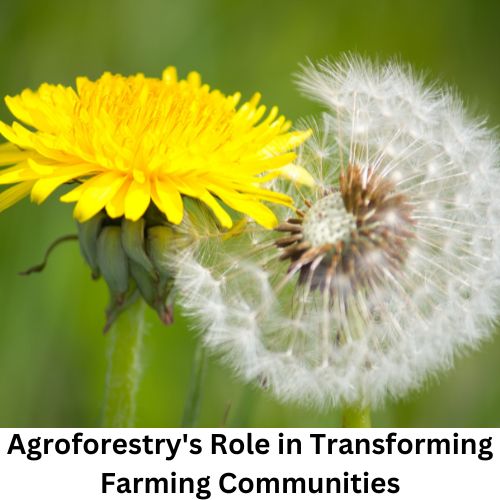Introduction
Rural areas often face neglect and stagnation in an era of rapid urbanization and modernization. However, there’s a quiet revolution occurring in these regions, driven by a centuries-old practice known as agroforestry. Agroforestry, the integration of trees and shrubs into farming systems, is revitalizing rural communities and playing a pivotal role in addressing critical global challenges such as climate change, food security, and environmental sustainability. This narrative explores the concept of rural renaissance through the lens of agroforestry, unraveling the principles, impact, success stories, challenges, and the transformative potential of this sustainable farming practice.
Chapter 1: Agroforestry’s Roots and Principles
We must first delve into its historical origins and fundamental principles to understand agroforestry’s role in rural renaissance.
1.1 Historical Roots
Ancient practices: Agroforestry has ancient origins, with civilizations like the Mesopotamians and Mayans integrating trees and crops into their farming systems.
Indigenous wisdom: Indigenous communities worldwide have embraced agroforestry for generations, maintaining biodiversity and sustainable livelihoods.
1.2 Modern Evolution
Emergence as a science: Agroforestry as a formalized concept gained recognition in the 1930s, marking the start of systematic research and development.
Key influencers: Pioneers like Robert Hart, J. Russell Smith, and Fikret Berkes shaped modern agroforestry principles and practices.
Chapter 2: Agroforestry’s Benefits for Rural Communities
Agroforestry benefits rural farming communities, creating a solid foundation for rural renaissance.
2.1 Economic Prosperity
Diversified income sources: Agroforestry systems often yield multiple products, including crops, timber, fruits, and medicinal plants, reducing economic risks.
Improved crop yields: Trees in agroforestry systems can enhance crop growth and yields.
2.2 Environmental Stewardship
Biodiversity conservation: Agroforestry promotes biodiversity by creating complex, multi-layered landscapes that provide habitats for various species.
Soil health and erosion control: Trees stabilize soil, prevent erosion, and enhance soil fertility, reducing the need for chemical fertilizers.
2.3 Climate Change Mitigation
Carbon sequestration: Trees in agroforestry systems capture and store carbon dioxide, mitigating the impacts of climate change.
Microclimate regulation: Trees provide shade and windbreaks, creating microclimates that benefit crops and livestock.
Chapter 3: Rural Renaissance through Agroforestry Initiatives
Rural communities worldwide are experiencing a renaissance, with agroforestry at its core. Success stories from various regions highlight the transformative potential of this practice.
3.1 Taungya System in Southeast Asia
Originating in Myanmar, the tangy system involves temporary tree planting among crops, promoting reforestation and enhancing land productivity.
Case study: The Philippines’ successful reforestation efforts through the tangy system.
3.2 Silvopasture in North America
Silvopasture combines trees, livestock, and forage in a mutually beneficial system, providing shade, improved forage quality, and enhanced animal welfare.
Case study: A rancher in the United States adopting silvopasture practices to boost cattle production while conserving natural habitats.
3.3 Alley Cropping in Africa
Alley cropping involves:
- Planting rows of trees amidst annual crops.
- Enhancing soil fertility.
- Providing additional income through tree products.
Case study: A smallholder farmer in Ghana using alley cropping to improve food security and income.
3.4 Homegardens in Southeast Asia
Home gardens are:
- Small-scale agroforestry systems around homes.
- Providing families with diverse food sources.
- Medicinal plants.
- Timber.
Case study: An Indonesian family practicing homegardening for nutritional needs and extra income.
Chapter 4: Challenges on the Road to Rural Renaissance
Despite its potential, agroforestry initiatives face several challenges that must be addressed to ensure a successful rural renaissance.
4.1 Land Tenure and Rights
Ambiguity in land tenure can discourage farmers from investing in agroforestry, as they fear losing their trees in case of land disputes.
4.2 Knowledge and Extension Services
Access to agroforestry knowledge and extension services in rural areas can help adoption. Initiatives to disseminate information are essential.
4.3 Policy Support
Government policies and international organizations can promote agroforestry through incentives, subsidies, and supportive regulations.
4.4 Market Access
Agroforestry products often need help accessing markets; value addition and market linkages can address this issue.
Chapter 5: Nurturing Rural Renaissance through Agroforestry
Specific steps and strategies must be employed to nurture rural renaissance through agroforestry truly.
5.1 Education and Training
Promote education and training programs to build capacity among farmers, extension workers, and policymakers in agroforestry practices.
5.2 Research and Innovation
Invest in research and innovation to develop new agroforestry techniques, tree species, and marketable products.
5.3 Policy Advocacy
Advocate for supportive policies at the local, national, and international levels to incentivize agroforestry adoption.
5.4 Financial Support
Encourage financial institutions to provide loans and credit to farmers interested in agroforestry, reducing financial barriers to entry.
5.5 Networking and Collaboration
Foster collaboration among stakeholders, including government agencies, NGOs, and farmers’ organizations, to create a supportive ecosystem for agroforestry.
Chapter 6: The Future of Rural Renaissance through Agroforestry
As the seeds of rural renaissance take root and flourish, the future holds tremendous promise. Agroforestry is poised to transform farming communities, revitalize rural areas, and simultaneously address global challenges.
6.1 Sustainable Rural Development
Agroforestry can catalyze sustainable rural development, generating economic growth, improving livelihoods, and conserving natural resources.
6.2 Climate-Resilient Agriculture
Agroforestry systems are inherently resilient to climate change, providing farmers a buffer against extreme weather events and changing growing conditions.
6.3 Food Security
By increasing agricultural productivity and diversifying food sources, agroforestry contributes significantly to global food security.
6.4 Biodiversity Conservation
Agroforestry systems promote biodiversity conservation by creating habitat diversity and preserving endangered species.
Conclusion
Rural renaissance is no longer a dream but a reality driven by the practice of agroforestry. This narrative has explored agroforestry’s roots, principles, benefits, and success stories, showcasing its transformative potential for rural communities. Despite its challenges, including land tenure issues and limited knowledge dissemination, agroforestry is at the forefront of rural renaissance efforts.
By nurturing agroforestry initiatives through education, research, policy advocacy, financial support, and collaboration, we can ensure a brighter future for rural areas worldwide. Agroforestry is not just about planting trees; it’s about sowing the seeds of sustainable development, resilience, and prosperity in the heart of our rural communities. As these seeds continue to grow, they hold the promise of a rural
